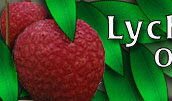How to Build a Soil for a Healthy Lychee Tree
By William Mee and Krystal Folino
Building and maintaining a good organic soil mix is essential to growing a healthy lychee tree. This soil is not something you can buy pre-mixed at a garden center, but is a complex mixture of components which form a living eco-system that interacts symbiotically with the tree's roots.
Organic material that finds it way into the soil is transformed by one set of organisms into a form usable by other organisms in the food web, eventually becoming available as a nutrient source for the tree. A healthy soil eco-system or "soil food web" contains beneficial fungi, bacteria, protozoa, nematodes, insects (arthropods), earth worms, soft compost and woody mulch.
Origins of Our Approach to Soil Building for Lychee Trees
It is widely believed that Lychee trees originated in the sub-tropical mountain rain forests of Southern China. Quite unlike cropland, these mountain rainforests survive and thrive without fertilization or other human intervention. The "soil food web" is the mechanism which makes this possible.
In the rain forest the organic material which fuels the soil food web comes from the rain of leaves, fruits, branches and runoff from the canopy and under-story. Plants and soil organism must survive through their dependence with each other. By products from growing roots and plant residue feed soil organisms and in turn soil organisms support plant health as they decompose organic matter, cycle nutrients, enhance soil structure and control the populations of soil organisms including crop pests.
Lychee trees evolved within this complex rain forest soil food web and thrive best when grown in soil conditions that exist in natural forest environments. There is a lot that you can do to improve the soil surrounding your lychee trees roots and the following tips describe some essential organisms and how you can supply them.
Earthworms Provide Composition and Structure for the Soil Eco-System
Earthworms consume organic matter and derive their nutrition from the bacteria and fungi growing on this material. Earthworms excrete wastes in the form of casts and move large amounts of material from the lower soil to the surface and move organic matter downward into deeper layers. Earthworms effectively mix and aggregate the soil, increase filtration, provide channels already filled with readily available nutrient which promote root growth. Furthermore earthworms bury and shred plant residue and improve the soil water retention capacity by increasing porosity.
In short, earthworms provide the "house" for the soil eco-system and without them little else can survive well.
You can obtain earthworms from your local bait store or collect night crawlers from a nearby forest. You must be sure that there is plenty of composted organic material available for the worms to eat.
Beneficial Soil Fungi Live Symbiotically on Lychee Tree Roots
Fungi in general are important as decomposers, nutrient cycling and disease suppression. A special type of fungi known as mycorrhiza colonizes plant roots in a symbiotic relationship supplying the plant with soil nutrients such as phosphorus, nitrogen and water. Photosynthetic root exudates in turn provide nutrition for the fungi. Natural soil may have a mycorrhizal population; however, you can improve this by inoculating your soil mix with commercially available mycorrhizal spores.
Urban soils for landscape lychee trees usually no natural population of beneficial fungi. Fungi decompose just about anything, but prefer the woody component of mulch.
Soil Arthropods are Essential, Not Insect Pests
Arthropods are segmented invertebrates (insects are arthropods as are crustaceans) and most every soil is home to many different arthropod species. Typical soil arthropods include springtails, beetles, ants, mites, sow bugs, spiders, centipedes and millipedes. Arthropods perform many important soil functions as they feed including shredding of organic material, soil aeration, mixing and aggregation, mineralization of plant nutrients as well as regulating other populations of other soil organism including pests.
The best way to establish or enhance a starting population of these creatures is to obtain surface soil from any nearby forest directly from the understory of existing trees. Even better is if you know someone with established lychee trees who will allow you to dig up some of the understory soil. You should include a good quantity of partially decomposed leaf litter and at least an inch of the humified soil beneath the surface litter
Soil Bacteria Serve Many Functions in Good Soil
Bacteria are a major food source for large populations of organisms living within the "soil food web". Various beneficial soil bacteria breaks down compost, mulch, leaf litter, insect carcasses, etc. into a form of nitrogen fertilizes the lychee tree. Some bacteria assist with soil structure by secreting substances that help the earthworms to aggregate the soil. Other forms of bacteria decompose pollutants in the soil and suppress disease. The area closest to the roots is filled with different kinds of specialized bacteria and fungi that thrive on plant cells sloughed off by the roots as well as sugars and proteins secreted by the roots.
Sterile potting soils purchased in garden centers do not have good bacterial populations. You can purchase commercially available fungi and soil bacteria and add this to your growing mix. Also add composted mulch which already has a healthy bacterial and fungal population.
Mulch and Compost
Once your tree is in place and there are some of the basic organisms available to convert organic material into a form usable by your lychee tree it is important to provide a continuing source of nutrients. Your food web creatures will begin working 24/7 to process the food and feed your lychee tree. To accomplish this you must provide composted mulch to the area over the root zone. This can easily be 6 inches or more deep making assurances not to pile compost directly against your tree's trunk. If you have a back yard composter, many of which are available through the Internet or mail order garden supply catalogs you can convert kitchen and yard waste into excellent compost.
You can also purchase "compost teas", worm castings and fish emulsions all of which are a great source of organic material for your "food web".
Monitor and Maintain your "Food Web"
You should routinely monitor the condition of the soil covering the root zone of your tree(s) and look for the signs of a healthy food web such as earthworm activity, springtails, millipedes and sow bugs. Verify that there is an ample supply of leaf litter covering the surface of the root zone. Brush aside the leaves and look for some of these creatures and verify that there are worm casts and smaller aggregates of humified material as you go deeper below the surface.
It may well be necessary to revitalize your food wed when something goes out of balance. Add mulch and compost when there appears to be insufficient humus. If there are no worm casts you may need to add both and fresh compost from a home composter.
Your lychee tree is a good indicator of what is going on below ground. Should your tree appear unhealthy such as leaf discoloring, leaf dieback or slow to no growth the first place you should look is to the soil. Most often, tree owners first reaction is to spray something on the tree, apply toxic chemical fertilizers or fungicides to the root zone. Use only natural organic materials whenever possible and you will be rewarded with a healthy vibrantly growing lychee tree.
|
|
|
Copyright © 1999-2010 Lychees Online
info@lycheesonline.com www.lycheesonline.com (954)648-6020

